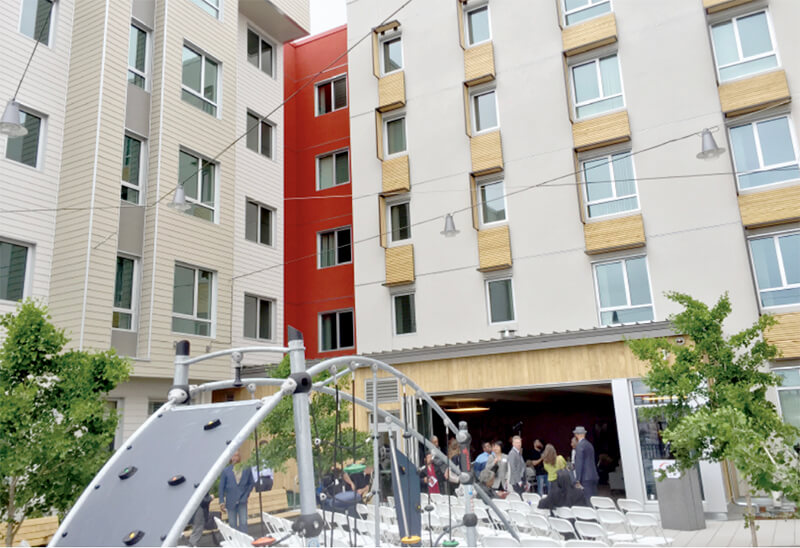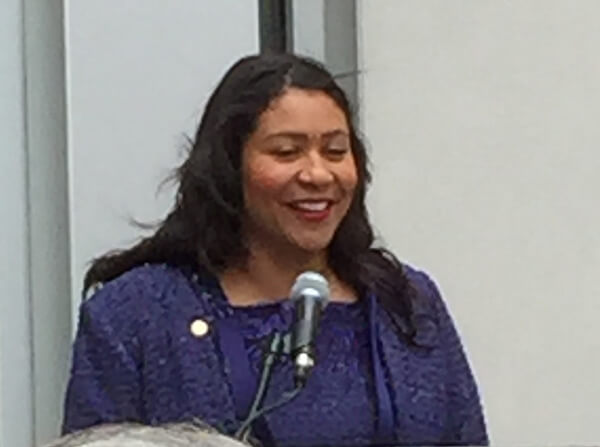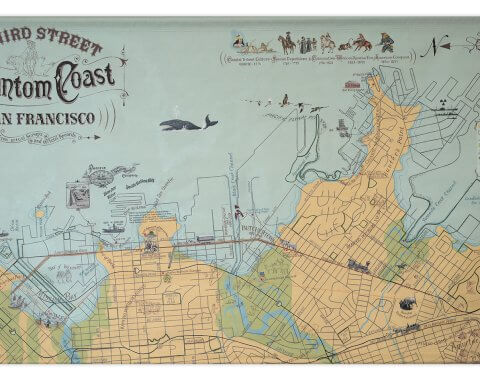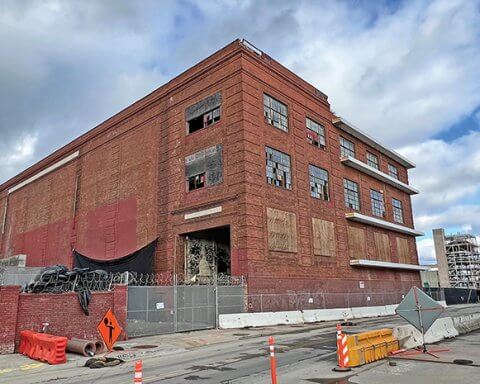
After years of political promises, 53 Potrero Terrace households moved into brand new apartments last month at recently constructed 1101 Connecticut Street. Once dubbed Project X, the building reflects completion of the initial phase of a plan to fully redevelop the Annex-Terrace complex into mixed income housing by 2029.

Johnnie Ledbetter was the first resident to relocate from a block of eight buildings southeast of Connecticut and 25th Streets, which’ll be razed later this year as part of the project’s second phase. The structures will be replaced by one edifice featuring market rate housing, and another with a 120-unit mix of affordable housing and current Terrace residents.
“It’s overwhelming right now trying to get situated but I’m glad and joyful,” said Ledbetter, who was a homeless single father with a daughter when he moved into the Terrace nine years ago. He won’t miss the mold, roaches and leaking pipes in his old unit, which he thought was no longer in livable condition. “As soon as you’d get something fixed, something else happened,” he said.
He’s eagerly looking forward to friends and family visiting him, something they wouldn’t do when he lived in 70-year-old housing associated with violent crime rates five times the City average. He’s already making plans to host Thanksgiving for the first time in his life.
Lisa Gant, a 25-year Terrace resident, was relieved to move after living next to two years of construction, which she believes stirred up a rat problem to compound other issues in the dilapidated buildings. “It’s much better. I love it because it’s new,” she said. Gant relocated along with her daughter and her daughter’s father, who is struggling with cancer.
Not all residents of the block were as fortunate. The 53 households won a lottery for space in the new building. Another 23 were moved into vacant units elsewhere in Annex-Terrace to wait for permanent relocation at a future phase. The developer, Bridge Housing, plans to transition residents one block at a time as new structures replace demolished ones. Project X was built on a vacant lot to allow that process to begin.
Eighteen of the 72 units at 1101 Connecticut are set aside for affordable housing, accessible to those earning between 60 and 80 percent of area median incomes, which’ll draw on registrants on the Database of Affordable Housing Listings, Information and Applications, the City’s affordable housing portal. A resident manager will live in the remaining unit.
District 10 Supervisor Shamann Walton, who previously served as Potrero Hill Family Resource Center director and lived on the 1700 block of Connecticut Street as a child, sees the structure’s opening as a step toward improving equity. “This doesn’t look like public housing,” he said at the grand opening last month. “It’s good to see residents can live in a wonderful brand-new building like this. This is personal and exciting to be here to witness the rebirth; to witness the beautiful homes on this side of Potrero Hill.”
When Rebuild Potrero is complete it’ll feature 1,675 units, a vast increase over the 606 that make up Annex-Terrace. There’ll also be 15,000 square feet of retail, a 25,000 to 35,000 square foot community center and 3.5 acres of public space. Phase Three will replace the Annex, the section east of the Potrero Hill Recreation Center. Phase Four will supplant the block southeast of 23rd and Wisconsin streets. The final phase will deal with the bulk of the Terrace, including extensions of Missouri and Arkansas streets to connect the road grid.
Thirty-five percent of the new homes will be market rate with the remaining a mix of affordable and public housing. According to Marie Debor, vice president of development for Bridge, it hasn’t been determined whether the market rate units will be rentals or condominiums but the leaning is toward the former.
All of this means a much denser population, with an emphasis on apartment-style living. Annex-Terrace features larger split-level units with doors leading to open space rather than a hallway. “You don’t have to deal with people like you do getting into an elevator,” said Ledbetter, expressing a need for the building to develop into a community.
There are also concerns about how well cultural diversities will mix. Edward Hatter, who has worked closely with the Annex-Terrace population for years as Potrero Hill Neighborhood House director, doesn’t think enough is being done to address potential social challenges. “All these people – market rate, working class and public housing residents – are supposed to get along and they have cultural habits they don’t share together,” he said. “We really need to think some things out.”
The biggest concern may be retention of existing public housing residents. During the 1990s, the federal Hope VI program attempted to convert public to mixed income housing throughout the country, but only 36 percent of inhabitants returned after being displaced during construction. As part of Hope SF, under which Rebuild Potrero falls, the City has been overseeing similar efforts at Hunters View, Sunnydale and Alice Griffith with a policy of not relocating occupants during erection activities. However, at Hunters View a third of residents chose not to stay, many believing promises wouldn’t be kept. And San Franciscans still remember redevelopment of the Fillmore after World War II which led to largescale displacement of the African-American community.
Since 2013, the City has been transferring ownership of housing projects to private nonprofits like Bridge and Mercy and, in the case of Alice Griffith, for-profit McCormick Baron Salazar. Hatter, who has studied the issue locally and nationally, said these organizations generally do a better job of managing the properties than government agencies but there’s potential for “a land grab” when it comes to privatizing municipally-owned parcels.

Mayor London Breed, who grew up in public housing in the Western Addition, where communities had been displaced by redevelopment, addressed the matter during a speech at the 1101 Connecticut opening. “We are not repeating the same mistakes. We want to guarantee Potrero Hill residents continue to live there,” she said. “We are fulfilling an old promise one building at a time.”
During phase one, a large number of vacancies in Annex-Terrace provided Bridge flexibility to move tenants within the complex who couldn’t fit into 1101 Connecticut. The vacancies are partially the result of the Housing Authority allowing existing buildings to lapse into disrepair. Last fall a $25 million accounting error was uncovered at the agency which led to a $7 million cut to the repair budget for Potrero Hill and Sunnydale public housing.
To help fulfill its promise of a one-for-one replacement of all Annex-Terrace households, Bridge is implementing or boosting existing health, education and employment programs. The nonprofit also offered tenants the option to relocate to other public housing, losing the right to return. Only two of the 78 households that had to be moved for Phase Two were transferred offsite, one was a man who was moved to Hunters View during the winter after his roof started to leak.
The man, a senior who had previously lived next door to mostly other seniors, has had trouble adjusting to a new apartment building at the complex due to the number of youngsters on his floor. Conversely there are concerns that residents coming from outside Annex-Terrace might not adjust well to the presence of children, particularly as a result of a rule Bridge has proposed that kids not have their own house keys. “This has been family housing for 50 years,” said Hatter, adding that latchkey kids are common.
In the 1940s, Annex-Terrace were constructed in a way that isolated it from the rest of the Hill, which ultimately led it to become a pocket of poverty. The two projects were managed separately, which resulted in further segregation and internal rivalries. Bridge’s studies have shown that, in addition to high crime, a quarter of residents are unemployed, a third are disabled and less than that have a bank account.
Breed, whose mother lived in Annex-Terrace, addressed the need for more dignified living situations in the future, stating “We want to be sure the next generation of people growing up in public housing have a completely different experience.”



